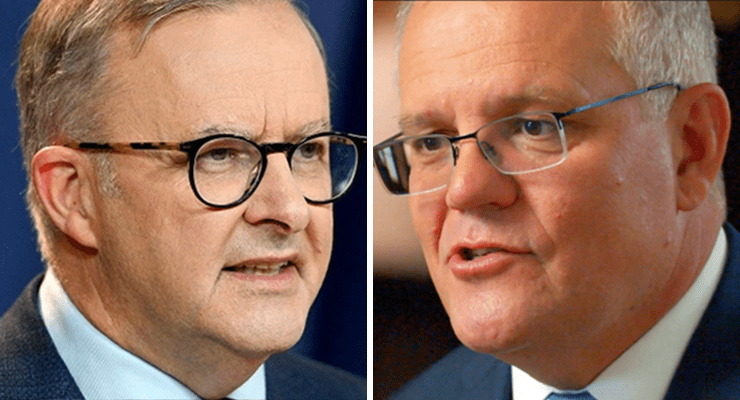
The 2022 federal election will be held on 21 May after Scott Morrison — the first Prime Minister since John Howard in 2007 to last a full term — this morning made the traditional trip to Yarralumla to ask the Governor-General to dissolve Parliament.
An election campaign that has been underway for months will now formally commence, with six weeks of electioneering ahead — a long campaign the Prime Minister hopes will wear down his opponent, Labor leader Anthony Albanese.
At a short press conference this morning, Morrison delivered a blunt message to voters: in an uncertain world, trust the devil you know.
“Above all, this election, as all elections are, this election is a choice. It’s a choice between a strong economy and a Labor opposition that would weaken it,” he said.
“It’s a choice between a strong and tested government team that has demonstrated our ability to make difficult and tough choices in tough times and a Labor opposition who has been so focused on politics over these past few years that they still can’t tell you what they do, who they are, or what they believe in.”
Morrison’s begins the campaign trailing Labor in the polls, in spite of Australia’s comparative global successes during the pandemic and strong economic position. Months of attacks on the prime minister’s character (mostly from his own side of politics), and perceptions that the government is incompetent during times of crisis, have eroded his personal standing among many voters.
Morrison conceded that his government was “not perfect,” but urged voters to overcome their dislike of him.
“This election — others will seek to make it about me — it’s about the people watching this right now. It’s about them.”
The prime minister spent just 11 minutes fielding questions during the opening press conference of the campaign, and gave away very little. He confirmed voters would know in the next week or so who would be replacing retiring Health Minister Greg Hunt if his government is returned. But he wouldn’t confirm if his front bench would remain the same. Asked if stood-down, scandal-plagued Education Minister Alan Tudge would return, the Prime Minister said he had never left.
“Alan Tudge is still in my cabinet.”
Now, despite admitting that people are “tired of politics,” Morrison has subjected the country to a protracted six week campaign, in order to try give himself time to run down Labor’s huge lead in the polls, hoping that a major mistake by Albanese, or a repeat of the prime minister’s strong campaigning performance in 2019, will get the Coalition back to level pegging.
Addressing reporters this afternoon with his own pre-election stump speech, Albanese tried to draw a distinction between a government lacking vision and a Labor opposition fresh with ideas to “build a better future”.
“This government doesn’t have an agenda for today, let alone a vision for tomorrow,” he said.
“They demonstrated that in their budget, which was nothing more than a ploy for an election campaign, with one-off payments to stop when the votes are counted.”
The opposition leader tried to draw a distinction between Morrison’s policy-lite pitch, promising stronger medicare, cheaper childcare, growing domestic manufacturing, a renewables sector delivering more jobs and lower-cost energy.
In a long, occasionally rambling press conference, Albanese also made a point of spending far more time with reporters, while also addressing fears his party’s small-target strategy has made him an obscure figure for some voters.
“I note that I’ve taken a lot more [questions] than my opponent did today,” he said.
Albanese cut a confident figure laying out his vision. And despite the ghosts of 2019 haunting Labor, he starts the campaign in a very strong position. According to polling expert William Bowe’s Pollbludger site, which aggregates all major polls, Labor currently holds an average two-party-prefered lead across polls of 55.3% to 44.7% over the Coalition, a national swing of 6.8%, with Labor’s primary vote on 39.5% and the Coalition on 34.4%, with the Greens on 9.6%. Labor has a 7.8 point 2PP lead in NSW, a 13-point lead in Victoria, a 0.8 point lead in Queensland, a 5.2% lead in WA and a 16.8 point lead in SA.
In each of those states, that represents a substantial — in some cases massive — swing to the opposition, but the polling gap will close dramatically between now and election day. There will also be considerable focus on seats such as Wentworth, North Sydney and Mackellar in Sydney, and an increasing number of regional seats as well, where Coalition members are under threat from independents.









Crikey is committed to hosting lively discussions. Help us keep the conversation useful, interesting and welcoming. We aim to publish comments quickly in the interest of promoting robust conversation, but we’re a small team and we deploy filters to protect against legal risk. Occasionally your comment may be held up while we review, but we’re working as fast as we can to keep the conversation rolling.
The Crikey comment section is members-only content. Please subscribe to leave a comment.
The Crikey comment section is members-only content. Please login to leave a comment.